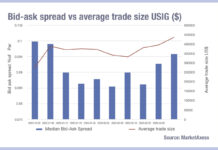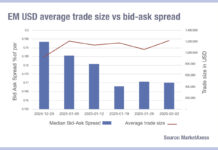There is a tension between best execution obligations and the longer-term value of a dealer supporting liquidity provision. Buy-side traders are aware that their dealers need to make a margin on trades to stay in the game profitably. Dealers know they need to provide risk transfer when clients need it in order for them to avoid suffering the worst. Neither side wants to extend the amount of margin or risk on offer beyond what is necessary.
The successful electronification of market making by new players has started to force traders to consider this equation.
The greater the number of players in a market, the more independence each player has from any other, and effective competition ought to prevent any one player from owning the game. However, if a technology is introduced which skews ‘effective’ competition so that it is less effective, then the mechanism for balancing out players can be quickly overwhelmed.
At the end of last year, in the bond markets, one electronic liquidity provider cleared up. Its capacity to provide consistently good pricing, irrespective of whether its dealers had gone on holiday, delivered a better outcome for buy-side traders.
Best execution rules suggest this was hitting all of the targets for buy-side firms. However, there are also concerns that shorter term economics of liquidity supply, could harm the longer term supply.
In other parts of the market near monopolies exist, and are often prevented by the forced support of rivals to the incumbent(s), with a view to managing pricing over the longer term through competitive pressure.
However, buy-side traders are also obliged to deliver best execution for their investors, not to challenge market structure.
Their case is not strengthened when dealers do not provide risk transfer in volatile markets; if market makers cannot prove effective at delivering liquidity more cheaply or reliably, they have little viability.
Buy-side desks are intelligent organisms and have evolved to support best execution in its many forms, be that based on price, speed of execution or size. That gives them some flexibility to meet liquidity providers in the negotiation process in a way that delivers best execution for clients without damaging dealer relationships.
Equally, investment banks and broker dealers are gradually developing both low and high touch offerings which let them work between low margin, high volume work and high margin low volume work.
A sell-side firm with a strong offering in both will be well positioned, but that is a challenging prosect for many. The internal politics of routing orders between high and low touch can be politically as well as practically challenging. The economics of developing an electronic offering is also a new development for many.
With 45-55% of investment grade trading in Europe and the US managed electronically, there is still a significant proportion being handled through human trading, and while the ticket number might be skewed to e-trading, the notional is not.
Relationships will continue to matter on both sides. where banks provide risk intermediation to buy-side clients. However, it will be incumbent upon dealers to deliver a solid combined offering of high and low touch execution services to create confidence in the market’s resilience in transferring liquidity.
©Markets Media Europe 2024

























